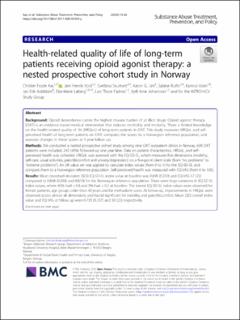| dc.contributor.author | Aas, Christer Frode | |
| dc.contributor.author | Vold, Jørn Henrik | |
| dc.contributor.author | Skurtveit, Svetlana | |
| dc.contributor.author | Lim, Aaron G. | |
| dc.contributor.author | Ruths, Sabine | |
| dc.contributor.author | Kamrul, Islam | |
| dc.contributor.author | Askildsen, Jan Erik | |
| dc.contributor.author | Løberg, Else-Marie | |
| dc.contributor.author | Fadnes, Lars T. | |
| dc.contributor.author | Johansson, Kjell Arne | |
| dc.date.accessioned | 2020-10-22T09:54:04Z | |
| dc.date.available | 2020-10-22T09:54:04Z | |
| dc.date.created | 2020-10-06T14:41:55Z | |
| dc.date.issued | 2020 | |
| dc.identifier.citation | Substance Abuse Treatment, Prevention, and Policy. 2020, 15:68 1-12. | en_US |
| dc.identifier.issn | 1747-597X | |
| dc.identifier.uri | https://hdl.handle.net/11250/2684421 | |
| dc.description.abstract | Background
Opioid dependence carries the highest disease burden of all illicit drugs. Opioid agonist therapy (OAT) is an evidence-based medical intervention that reduces morbidity and mortality. There is limited knowledge on the health-related quality of life (HRQoL) of long-term patients in OAT. This study measures HRQoL and self-perceived health of long-term patients on OAT, compares the scores to a Norwegian reference population, and assesses changes in these scores at 1-year follow up.
Methods
We conducted a nested prospective cohort study among nine OAT outpatient clinics in Norway. 609 OAT patients were included, 245 (40%) followed-up one year later. Data on patient characteristics, HRQoL, and self-perceived health was collected. HRQoL was assessed with the EQ-5D-5L, which measures five dimensions (mobility, self-care, usual activities, pain/discomfort and anxiety/depression) on a five-point Likert scale (from “no problems” to “extreme problems”). An UK value set was applied to calculate index values (from 0 to 1) for the EQ-5D-5L and compare them to a Norwegian reference population. Self-perceived health was measured with EQ-VAS (from 0 to 100).
Results
Mean (standard deviation (SD)) EQ-5D-5L index value at baseline was 0.699 (0.250) and EQ-VAS 57 (22) compared to 0.848 (0.200) and 80(19) for the Norwegian reference population. There were large variations in EQ-5D-5L index values, where 43% had > 0.8 and 5% had < 0.2 at baseline. The lowest EQ-5D-5L index values were observed for female patients, age groups older than 40 years and for methadone users. At follow-up, improvements in HRQoL were observed across almost all dimensions and found significant for mobility and pain/discomfort. Mean (SD) overall index value and EQ-VAS at follow up were 0.729 (0.237) and 59 (22) respectively.
Conclusion
The average HRQoL and self-perceived health of OAT patients is significantly lower than that of the general population, and lower than what has been found among other severe somatic and psychiatric conditions. Around 34% had very good HRQoL, higher than average Norwegian values, and around 5% had extremely poor HRQoL. | |
| dc.language.iso | eng | en_US |
| dc.rights | Navngivelse 4.0 Internasjonal | * |
| dc.rights.uri | http://creativecommons.org/licenses/by/4.0/deed.no | * |
| dc.title | Health-related quality of life of long-term patients receiving opioid agonist therapy: a nested prospective cohort study in Norway | en_US |
| dc.type | Peer reviewed | en_US |
| dc.type | Journal article | en_US |
| dc.rights.holder | © 2020, Authors | |
| dc.description.version | publishedVersion | |
| cristin.ispublished | true | |
| cristin.fulltext | original | |
| cristin.qualitycode | 1 | |
| dc.identifier.doi | 10.1186/s13011-020-00309-y | |
| dc.identifier.cristin | 1837645 | |
| dc.source.journal | Substance Abuse Treatment, Prevention, and Policy | en_US |
| dc.source.volume | 15:68 | en_US |
| dc.source.pagenumber | 1-12 | en_US |

